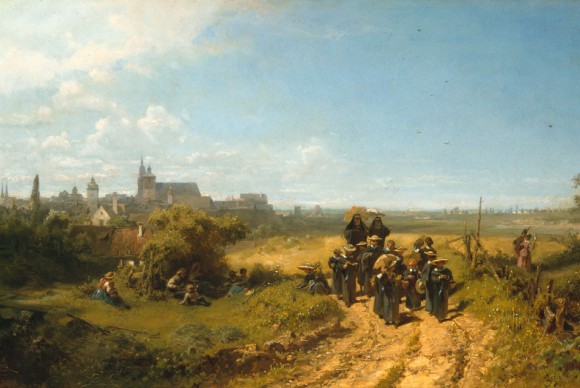Provenance researchers in Munich continue the work of the Monuments Men
February 25, 2014 by All Art News
Filed under Education & Research
MUNICH.- The Bayerische Staatsgemäldesammlungen are pursuing their duty to examine their holdings according to the standards and recommendations defined in the common declaration and the Washington Principles (drawn up at the Washington Conference on Holocaust-Era Assets with regard to works of art confiscated by the Nazis).
An unconventional special unit of the US Army, a team of scholars and art experts, moved across war-torn Europe 70 years ago – the ‘Monuments, Fine Arts and Archives ’ department, famous from Robert M. Edsel’s book and George Clooney’s film as ‘The Monuments Men’. Their brief was to save works of art from destruction and seize looted art. At the top of the list of people targeted was Hitler’s personal photographer, Heinrich Hoffmann.

Carl Spitzweg, Der Institutsspaziergang, c. 1860. Oil on Canvas, 32,1 x 54,1 cm. Bayerische Staatsgemäldesammlungen, Neue Pinakothek, Munich.
Through his portraits of the ‘Führer’ and pictures of Nazi marches, Hoffmann earned millions during the Third Reich. As was typical of elite leaders in the Nazi regime he invested considerable sums in art. His interest lay in paintings by the Bavarian painter Carl Spitzweg (1808–85), in particular, and he even boasted having the best Spitzweg collection in the world.
In April 1945, Heinrich Hoffmann was captured by the US Army in Oberwössen in the Chiemgau region and questioned. ‘Monuments man’ Harry Ettlinger acted as interpreter. The ‘monuments men’ set about impounding Hoffmann’s art collection that had been hidden in various places in Bavaria to protect it from air raids.
Art experts in the US forces found the Spitzweg painting ‘Institutsspaziergang’, for example, in Dietramszell Monastery, south of Munich . As was the case with tens of thousands of other works of art, the ‘monuments men’ also sent this picture to Munich to the so-called Central Collecting Point that the US military government and Jim Rorimer, under the direction of the young art historian Craig Hugh Smyth, had set up in the former NSDAP headquarters on Königsplatz. It was here that American experts gathered all the works rescued from places such as Dietramszell Monastery and Neuschwanstein Castle . Their objective was to clarify whether the works in question were museum holdings placed there for safe-keeping or looted works of art from Jewish owners or collections from countries occupied by the Germans. For their investigations the art protection team confiscated sales documents, among other things, and questioned suspects, including the director of the Bayerische Staatsgemäldesammlungen, Ernst Buchner. This method proved in general to be very successful. During the first few years after the war it was possible for the greater part of the objects in question, several hundred thousand works of art in total, to be returned to their rightful owners. In the case of the painting ‘Institutsspaziergang’, owned by Heinrich Hoffmann, no evidence could be found for it to be classified as looted art. Hoffmann was ultimately labelled a main culprit in the course of de-Nazification. The sentence against the ‘NSDAP picture agent’ was four years’ imprisonment and expropriation. According to the conditions stipulated in directive no. 50, issued by the Allied Control Council that the Occupation Forces had put into effect, the painting ‘Institutsspaziergang’ also came into the possession of the Free State of Bavaria along with Hoffmann’s other assets. In 1957 the picture subsequently entered the holdings of the Neue Pinakothek.
Provenance researchers at the Bayerische Staatsgemäldesammlungen are now looking into this case once again. Together with other pictures and sculptures in the possession of leading Nazis and members of the NSDAP that entered the holdings of the Pinakothek museums as ‘transferals of government-owned property’, they are now taking another look at the history of ‘Institutsspaziergang’. As its theft or loss as a result of persecution cannot be definitively excluded at present, a report has already been uploaded onto the Internet platform ‘Lost Art’ where the present status of information on the painting can be viewed by the public and possible owners can stake their claims. The painting ‘Institutsspaziergang’ is one of currently 174 works of art that have been registered on ‘Lost Art’ (www.lostart.de) by the Bayerische Staatsgemäldesammlungen. As such, the Bayerische Staatsgemäldesammlungen are pursuing their duty to examine their holdings according to the standards and recommendations defined in the common declaration and the Washington Principles (drawn up at the Washington Conference on Holocaust-Era Assets with regard to works of art confiscated by the Nazis).
Research work on this picture is still on-going. With the help of additional sources, provenance researchers are attempting to stop previous gaps and clarify the origin of the Spitzweg painting beyond doubt.
